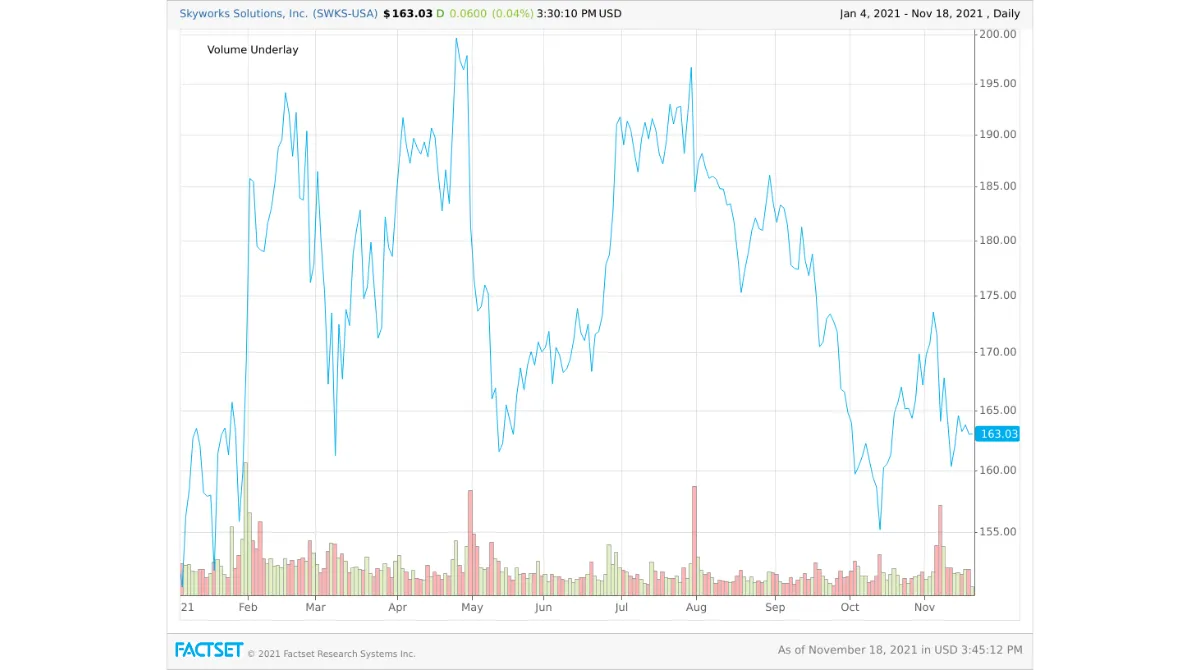Polkadot is a Web 3.0 blockchain project built to rival Ethereum on speed and cost. Indeed, its founder, Gavin Wood, was a co-founder of Ethereum. Polkadot has been sitting in the top ten cryptocurrencies by market cap for some time now and is at number eight at the time of writing.
#What is Polkadot worth today?
Polkadot's cryptocurrency token DOT is worth around $40 today, and volatility is high. The Polkadot price soared between January and the height of the meme stock craze in February. With continued volatility, it made higher highs through to mid-May when the Bitcoin price peaked, and all cryptos took a dip.

By July, it was 78% off its May high. It then began to rally once more and reached higher highs of $55 once again in early November. Since then, it's fallen 28%.
Although cryptocurrencies are becoming more accessible, the volatility shows no signs of slowing.
#What is Polkadot used for?
One reason for Polkadot's surging popularity this year coincides with the explosive interest in NFTs.
Minting, selling and trading NFTs is big business, but the fees associated with minting on Ethereum are extortionate, and Polkadot offers investors a cheaper alternative.
The trading of digital art in the form of NFTs has taken on a life of its own, with several big-name brands getting in on the action. It's become so big the annual industry event NFT.NYC attracted over 5,000 visitors this year, which took place in New York for three days from 1 November. The main event features speakers like Reddit co-founder Alexis Ohanian and entrepreneur Gary Vaynerchuk. Meanwhile, a spin-off event hosted by the Bored Ape Yacht Club attracted scores of pseudonymous NFT holders and a ton of publicity.
Polkadot provides the protocol to allow for interoperable asset transfers. That's because Polkadot enables cross-blockchain transfers of any type of data or asset, not just tokens.
Thus, users can interoperate with a wide variety of blockchains in the Polkadot network.
#What is special about polkadot?
The problem Polkadot solves is that it can help individual blockchain projects interact and connect with other individual blockchain projects.
It offers layer zero operability that will allow blockchains to be built, used and scaled easily from the ground up.
Polkadot is a proof of stake blockchain running on a hub and spoke model. Its central hub is the relay chain, and parachains (spokes) feed into this to achieve consensus at the hub.
Its proof of stake nature means people wanting to use the network must stake at least 10,000 DOT coins. This ensures the validators are financially invested and have no incentive to cheat.
The parachains do their own thing, but every so often, they sync up with the relay chain at the hub to confirm everything is safe, secure and in sync.
This shared security option offers huge appeal to individual blockchain projects because it saves them the trouble and cost of securing their own networks.
As an example of this in action, take The Covalent Network, a Web 3.0 data analytics company. The Covalent Network offers public access to a decentralized data infrastructure layer of Web 3.0. It will be governed by Covalent Query Token (CQT), with Moonbeam as its settlement layer.
Moonbeam is a decentralized application (dApp) that is launching as a parachain on Polkadot. It is a developer-friendly blockchain providing compatibility with the existing Ethereum network and corresponding development tools. But its location on a parachain lets it leverage all of Polkadot's features, such as faster processing rates, low costs, and high security.
#The Treasury and Kusama
Polkadot has two main tools that give it robust appeal. The Treasury and its test network Kusama enable Polkadot's efficient, responsive scalability.
The treasury is a pot of funds accumulated from transaction fees, staking inefficiencies and more. These funds help to improve the framework. Stakeholders can propose how the funds are spent on infrastructure, network security, ecosystem provisions, marketing and more.
Meanwhile, Kusama is a practice network where people can test and experiment while putting up real monetary stakes.
Polkadot can be upgraded simply, without requiring the hard forks that legacy blockchain systems need. This means it can adapt quickly and cheaply when the need arises.
#What is sharding?
Sharding breaks the blockchain into individual shards that process transactions independently. This capability sets Polkadot apart from legacy crypto systems because it can massively transform the speeds at which cryptocurrency transactions can take place. In time this will ensure scalability is much more likely.
#Polkadot projects
Polkadot projects have raised over 87.6 million DOT ($3.44bn) to date. Polkadot's parachain development is still undergoing heavy development, but it put its first parachain up for auction earlier this month. DeFi protocol Acala won after raising 32.5m DOT ($1.28bn) from 24,934 contributors via an initial coin offering (ICO).
Other parachain projects in existence are Astar, Clover Finance, Manta Network, Moonbeam, and Parallel Finance.
Moonbeam is projected to win the next Polkadot parachain auction.
Moreover, Polkadot partnerships are also getting noticed.
Firstly Polkadot has partnered with Chainlink to use its Oracle network. This will allow it to integrate smart contracts into the blockchain containing real-world data.
It is also partnering with Ankr StakeFi to give DOT holders a chance to stake their crypto for rewards through the Ankr parachain.
With many real-world businesses making a transition to the metaverse, Polkadot is an obvious choice. It is often featured among other prominent web 3.0 ecosystems like Ethereum, Cardano, Cosmos, and Solana.
